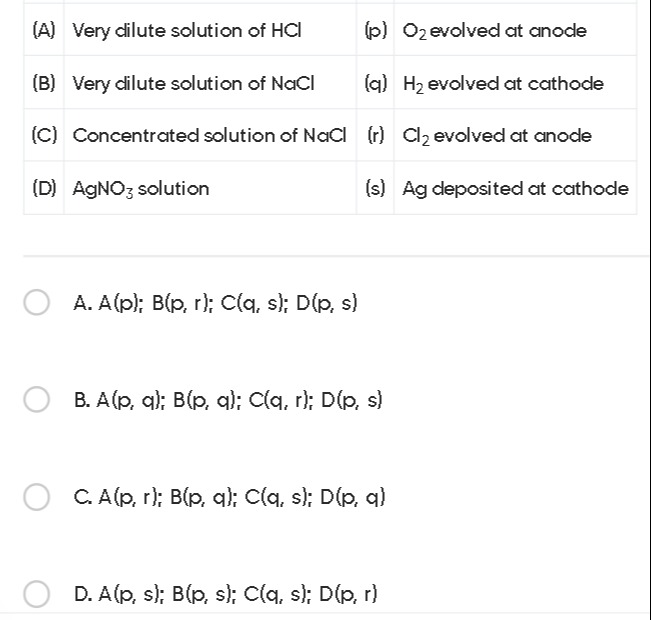Question
Question: (A) Very dilute solution of HCI (p) O$_2$ evolved at anode (B) Very dilute solution of NaCl (q) H$_...
(A) Very dilute solution of HCI (p) O2 evolved at anode (B) Very dilute solution of NaCl (q) H2 evolved at cathode (C) Concentrated solution of NaCl (r) Cl2 evolved at anode (D) AgNO3 solution (s) Ag deposited at cathode

A(p); B(p, r); C(q, s); D(p, s)
A(p, q); B(p, q); C(q, r); D(p, s)
A(p, r); B(p, q); C(q, s); D(p, q)
A(p, s); B(p, s); C(q, s); D(p, r)
B
Solution
The electrolysis of aqueous solutions involves competition between the reduction of cations and water at the cathode, and the oxidation of anions and water at the anode. The species with the more favorable (less negative for reduction, less positive for oxidation) standard electrode potential will react preferentially, with consideration for overpotential and concentration effects.
Let's analyze each case:
(A) Very dilute solution of HCl
- Species present: H⁺, Cl⁻, H₂O
- At Cathode (Reduction):
- H⁺(aq) + e⁻ → ½ H₂(g) (E° = 0.00 V)
- 2H₂O(l) + 2e⁻ → H₂(g) + 2OH⁻(aq) (E° = -0.83 V at pH 7) Since it's an acidic solution, H⁺ is reduced preferentially. So, H₂ is evolved at the cathode (q).
- At Anode (Oxidation):
- 2Cl⁻(aq) → Cl₂(g) + 2e⁻ (E° = +1.36 V)
- 2H₂O(l) → O₂(g) + 4H⁺(aq) + 4e⁻ (E° = +1.23 V) For very dilute HCl, the concentration of Cl⁻ is very low. Water has a lower standard oxidation potential than Cl⁻. Therefore, water is preferentially oxidized. So, O₂ is evolved at the anode (p).
- Match for (A): (p, q)
(B) Very dilute solution of NaCl
- Species present: Na⁺, Cl⁻, H₂O
- At Cathode (Reduction):
- Na⁺(aq) + e⁻ → Na(s) (E° = -2.71 V)
- 2H₂O(l) + 2e⁻ → H₂(g) + 2OH⁻(aq) (E° = -0.83 V at pH 7) Water has a much higher reduction potential than Na⁺. So, H₂ is evolved at the cathode (q).
- At Anode (Oxidation):
- 2Cl⁻(aq) → Cl₂(g) + 2e⁻ (E° = +1.36 V)
- 2H₂O(l) → O₂(g) + 4H⁺(aq) + 4e⁻ (E° = +1.23 V) Similar to very dilute HCl, for very dilute NaCl, the concentration of Cl⁻ is very low. Water is preferentially oxidized over Cl⁻. So, O₂ is evolved at the anode (p).
- Match for (B): (p, q)
(C) Concentrated solution of NaCl
- Species present: Na⁺, Cl⁻, H₂O
- At Cathode (Reduction):
- Na⁺(aq) + e⁻ → Na(s) (E° = -2.71 V)
- 2H₂O(l) + 2e⁻ → H₂(g) + 2OH⁻(aq) (E° = -0.83 V at pH 7) Water is preferentially reduced. So, H₂ is evolved at the cathode (q).
- At Anode (Oxidation):
- 2Cl⁻(aq) → Cl₂(g) + 2e⁻ (E° = +1.36 V)
- 2H₂O(l) → O₂(g) + 4H⁺(aq) + 4e⁻ (E° = +1.23 V) Although the standard oxidation potential of water is lower, in concentrated solutions of Cl⁻, the high concentration of Cl⁻ and the significant overpotential required for O₂ evolution on common electrode materials (like graphite) make the oxidation of Cl⁻ to Cl₂ kinetically and thermodynamically more favorable. So, Cl₂ is evolved at the anode (r).
- Match for (C): (q, r)
(D) AgNO₃ solution
- Species present: Ag⁺, NO₃⁻, H₂O
- At Cathode (Reduction):
- Ag⁺(aq) + e⁻ → Ag(s) (E° = +0.80 V)
- 2H₂O(l) + 2e⁻ → H₂(g) + 2OH⁻(aq) (E° = -0.83 V at pH 7) Ag⁺ has a much higher reduction potential than water. So, Ag is deposited at the cathode (s).
- At Anode (Oxidation):
- NO₃⁻ is very difficult to oxidize.
- 2H₂O(l) → O₂(g) + 4H⁺(aq) + 4e⁻ (E° = +1.23 V) Water is preferentially oxidized. So, O₂ is evolved at the anode (p).
- Match for (D): (p, s)
Summary of Matches:
- (A) Very dilute solution of HCl: A(p, q)
- (B) Very dilute solution of NaCl: B(p, q)
- (C) Concentrated solution of NaCl: C(q, r)
- (D) AgNO₃ solution: D(p, s)
Comparing this with the given options, option B matches our derived results.
